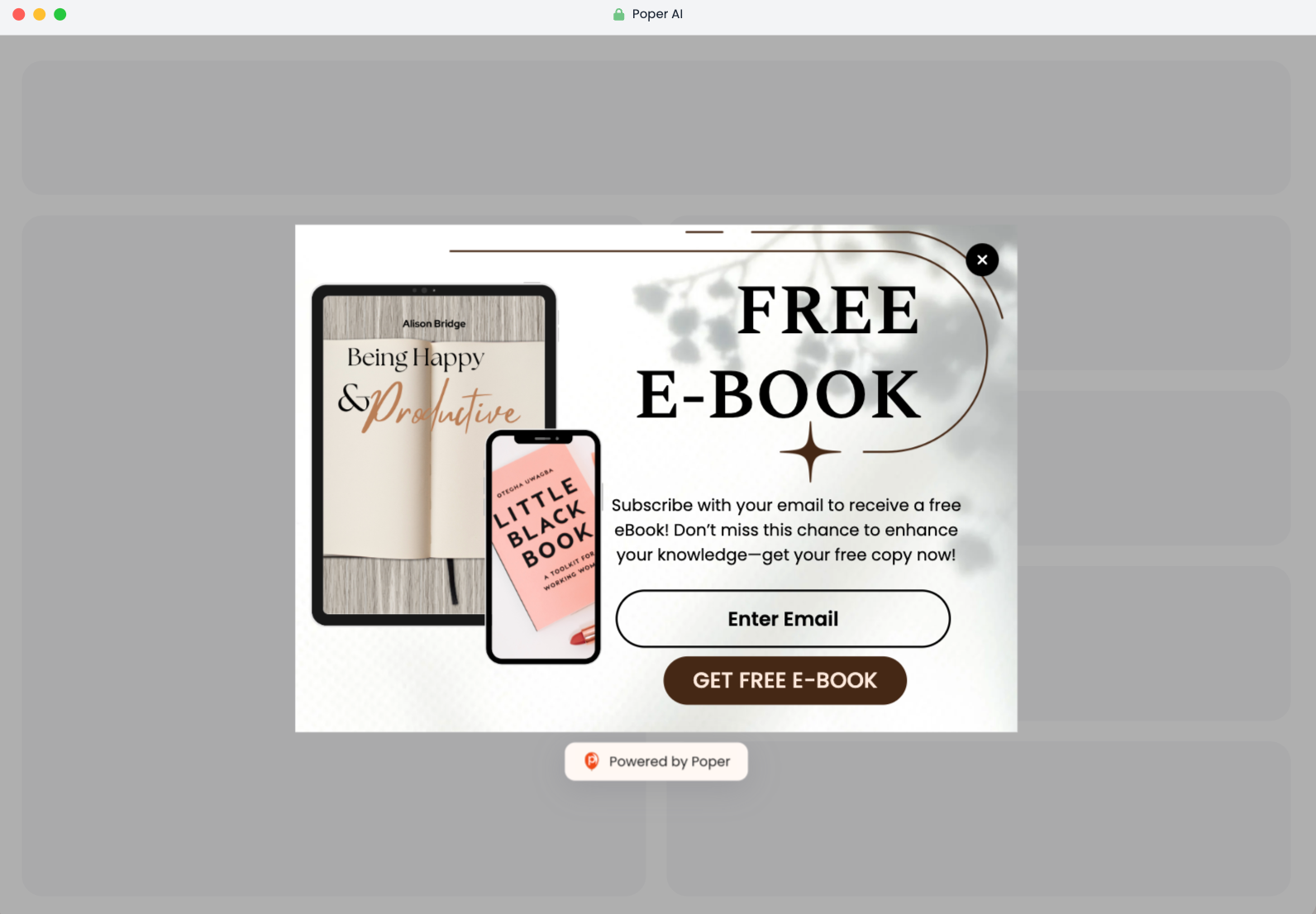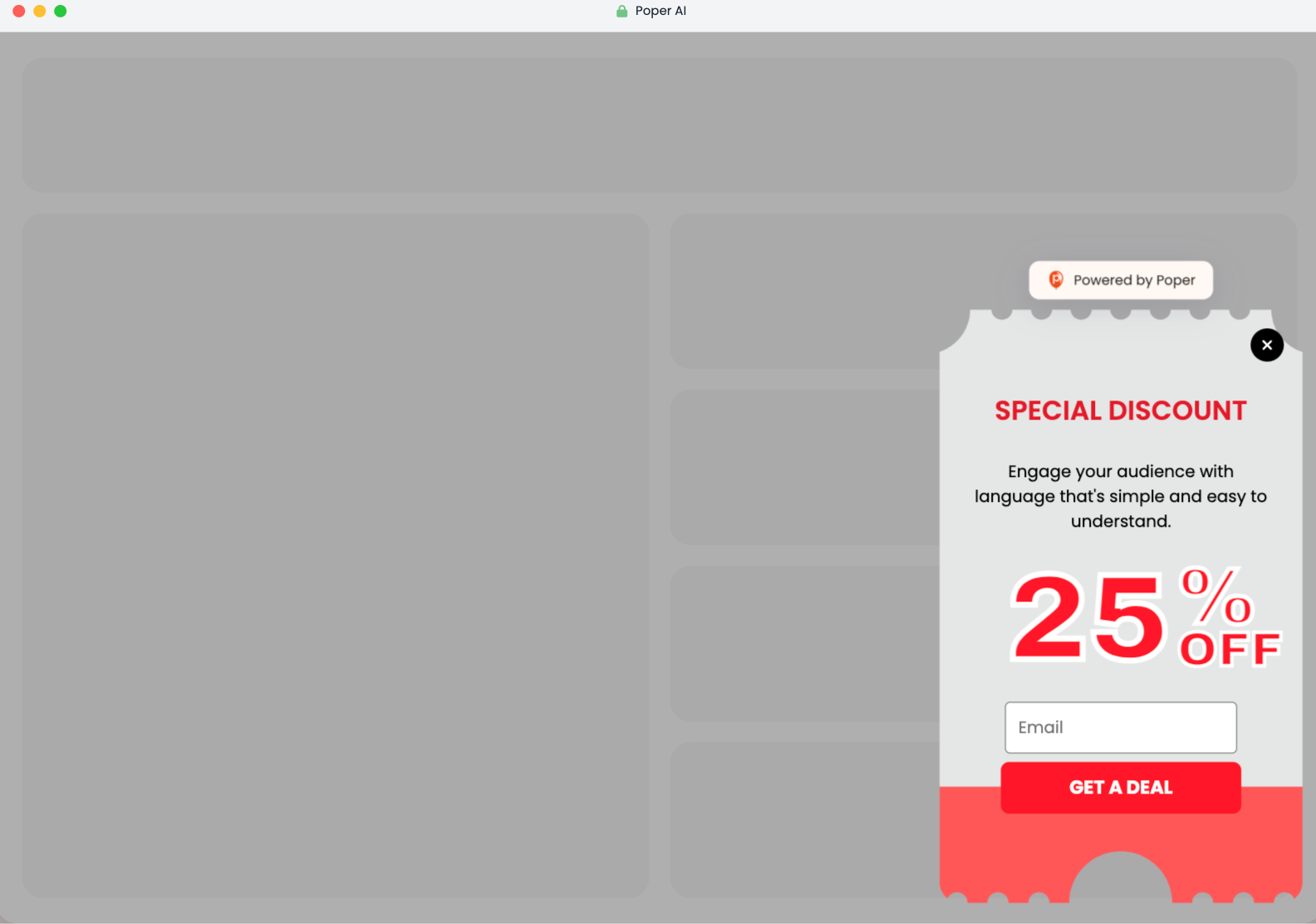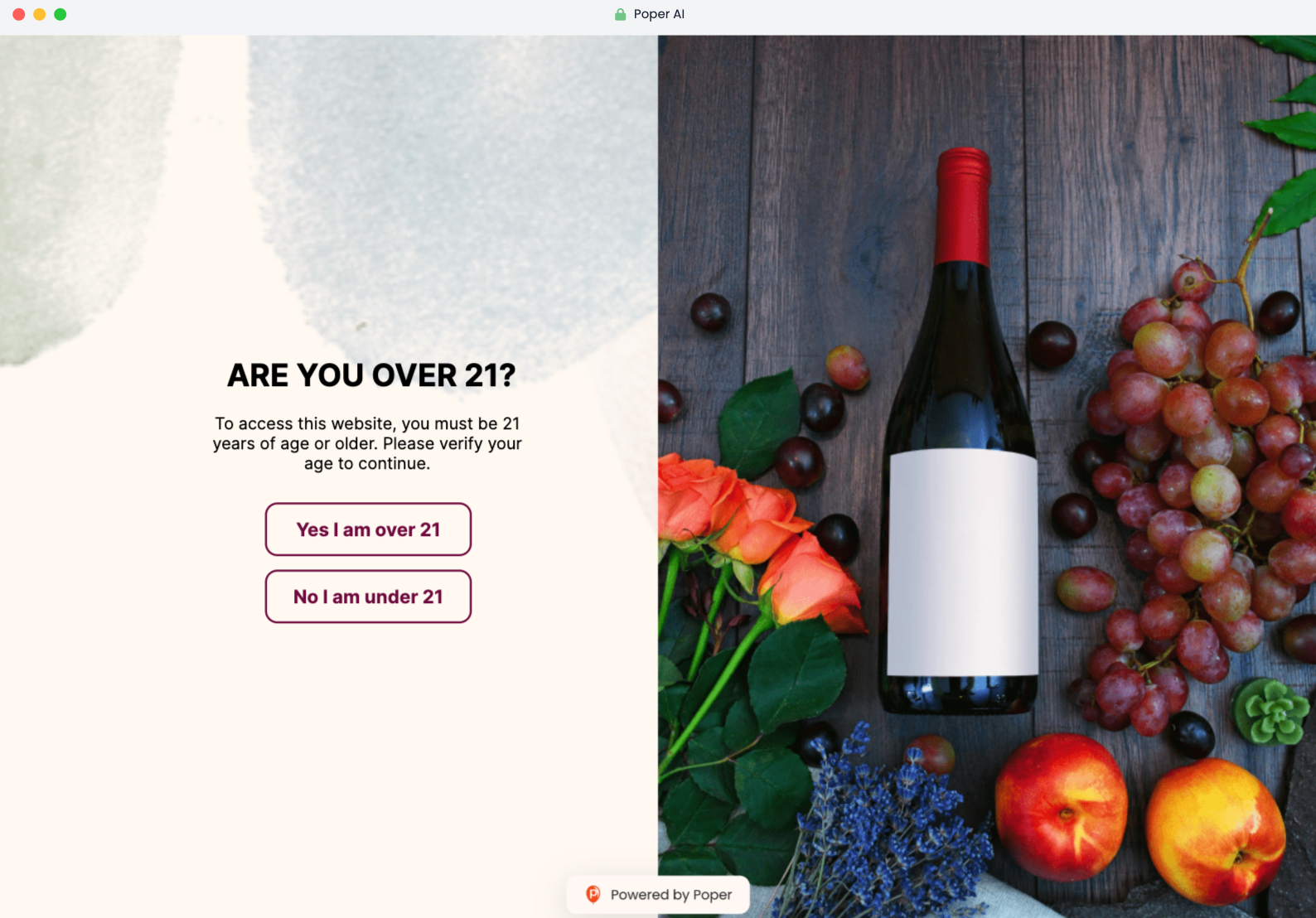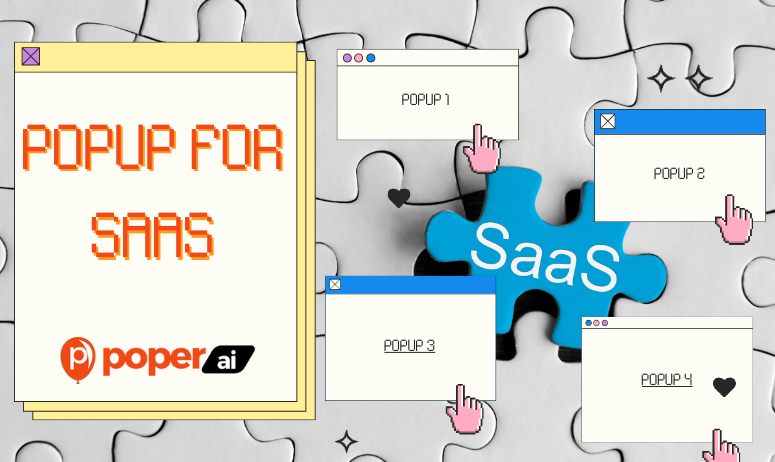Popups have become an essential tool in the Software as a Service (SaaS) industry, serving as a dynamic way to engage users, gather feedback, and drive conversions. They are versatile elements that can be strategically placed across your platform to achieve various business objectives.
Popups are not just interruptions; they are opportunities to engage, inform, and convert your users at the right moment.
Popups in SaaS can take many forms, from welcome messages and promotional offers to exit-intent prompts and feedback forms. Their primary role is to enhance user engagement and facilitate actions that benefit both the user and the business.
Understanding Different Types of Popups
Lightbox Popups

Lightbox popups are one of the most common types of popups, characterized by their ability to dim the background and draw full attention to the popup content.
Definition and Use Cases: Lightbox popups appear in the center of the screen and are typically used for important messages, such as subscription forms, special offers, or announcements.
Pros and Cons:
Pros: High visibility, effective at capturing attention, and suitable for critical messages.
Cons: Can be seen as intrusive if not used judiciously, may interrupt the user experience if poorly timed.
Slide-in Popups

Slide-in popups are less intrusive, appearing from the side of the screen as the user scrolls or engages with content.
Definition and Use Cases: These popups are ideal for promoting secondary offers, providing additional information, or suggesting related content.
Pros and Cons:
Pros: Subtle, less disruptive, and can be engaging without interrupting the user flow.
Cons: May be overlooked if not designed effectively, less impactful for urgent messages.
Banner Popups

Banner popups appear at the top or bottom of the screen and are generally used for brief announcements or calls to action.
Definition and Use Cases: Commonly used for cookie consent, flash sales, or site-wide notifications.
Pros and Cons:
Pros: Minimal disruption, easy to dismiss, and great for ongoing notifications.
Cons: Limited space for content, might be ignored by users.
Full-Screen Overlays

Full-screen overlays cover the entire screen, demanding complete attention from the user.
Definition and Use Cases: Used for major announcements, onboarding tutorials, or to present critical information.
Pros and Cons:
Pros: Maximum visibility, ensures the message is seen.
Cons: Highly intrusive, should be used sparingly to avoid frustrating users.
Exit-Intent Popups

Exit-intent popups detect when a user is about to leave the site and display a message aimed at retaining the user.
Definition and Use Cases: Effective for last-minute offers, feedback requests, or preventing cart abandonment.
Pros and Cons:
Pros: Target users who are about to leave, potentially converting exits into engagements.
Cons: May come too late in the user journey to change behavior significantly.
Planning Your Popup Strategy
Identifying Goals and Objectives
Before implementing popups on your SaaS platform, it’s essential to identify your primary goals and objectives. Knowing what you want to achieve will guide the design, content, and placement of your popups.
Common Goals:
Increasing Sign-Ups: Encourage visitors to sign up for a newsletter, free trial, or full subscription.
Reducing Churn: Use popups to engage users who are at risk of leaving by offering incentives or support.
Collecting Feedback: Gather user insights to understand their needs, preferences, and pain points.
Aligning Popups with Business Objectives: Ensure that each popup serves a specific purpose that aligns with your overall business strategy. For example, if your goal is to increase trial sign-ups, create a compelling popup that highlights the benefits of starting a trial.
Target Audience Segmentation
Segmenting your audience allows you to create more targeted and relevant popups. Different user segments have different needs and behaviors, and your popups should reflect that.
Behavior-Based Segmentation: Group users based on their actions on your site, such as pages visited, time spent, and interactions. Tailor popups to these behaviors to increase relevance.
Demographic Segmentation: Use demographic information like age, location, and industry to customize popups. For example, a popup offering a discount might be more effective if it’s personalized for specific regions.
Designing Effective Popups
Crafting Compelling Headlines and CTAs
The headline and call-to-action (CTA) are critical components of any popup. They need to be attention-grabbing and persuasive to encourage user engagement.
Importance of Strong Headlines: Your headline should immediately convey the value proposition. It needs to be clear, concise, and compelling. For instance, “Unlock Premium Features – Start Your Free Trial Now!”.
Creating Effective CTAs: The CTA should prompt immediate action and be aligned with the user’s interest. Use action-oriented language like “Get Started,” “Download Now,” or “Sign Up Today.”
Visual Design Best Practices
An aesthetically pleasing popup is more likely to catch the user’s eye and convey your message effectively.
Choosing Colors, Fonts, and Images: Ensure that the design elements are consistent with your brand’s visual identity. Use contrasting colors to make the CTA stand out, and select fonts that are easy to read.
Ensuring Mobile Responsiveness: Many users will interact with your popups on mobile devices. Make sure your popups are designed to be responsive and look good on all screen sizes.
Writing Engaging Popup Content
The content of your popup should be concise and persuasive, providing users with a clear reason to take action.
Tips for Concise and Persuasive Messaging: Keep your message short and to the point. Highlight the benefits and use bullet points to make the content easy to scan.
Using Social Proof and Urgency: Incorporate elements like customer testimonials, ratings, and limited-time offers to create urgency and build trust.
How to Create Popups for SaaS Using Poper
Creating effective popups for your SaaS platform using Poper is straightforward and can significantly enhance user engagement and conversions. Here’s a step-by-step guide to help you create impactful popups with Poper.
Step 1: Sign Up and Set Up Your Account
Before you start creating popups, you need to sign up for a Poper account and set up your dashboard.
Sign Up: Visit the Poper website and sign up for an account by providing the necessary details about your SaaS platform.
Set Up Dashboard: Once your account is created, navigate to your dashboard where you can manage all your popups.
Step 2: Choose the Type of Popup

Poper offers various types of popups to suit different purposes. Choose the one that aligns with your specific goals.
Select from Templates: Poper provides professionally designed templates that can be customized to fit your brand and objectives. Choose a template that matches your campaign, whether it’s for sign-ups, feedback, or promotions.
Start from Scratch: If you prefer complete control over the design, you can start from scratch and build your popup from the ground up.
Use AI-Generated Designs: Poper’s AI feature can generate personalized popup designs based on your inputs, saving you time and ensuring high relevance.
Step 3: Customize Your Popup

Customization is key to making your popups stand out and resonate with your audience.
Design: Use Poper’s drag-and-drop builder to customize your popup. Adjust colors, fonts, images, and layout to match your brand’s identity. Ensure that the design is visually appealing and consistent with your overall aesthetic.
Content: Write clear and compelling content. The headline should be attention-grabbing, and the call-to-action (CTA) should be persuasive and direct. For example, “Start Your Free Trial Now!” or “Get Exclusive Access Today!”.
Timing and Triggers: Set up triggers to control when and how your popup appears. Options include time on page, scroll depth, exit intent, and specific user actions. This ensures that your popup appears at the most opportune moments.
Step 4: Apply AI and Audience Filtering

Poper’s AI and audience filtering features allow you to target your popups more effectively.
Use AI for Dynamic Content: Enable AI to dynamically adjust content based on user behavior and preferences. For example, show different messages to new users versus returning users.
Audience Filtering: Segment your audience to display specific popups to different user groups. For instance, offer a discount to first-time visitors and a loyalty reward to returning customers.
Step 5: Integrate and Publish

Seamless integration ensures your popups enhance the user experience without disrupting it.
Embed the Popup Code: Follow Poper’s integration instructions to embed the popup code into your SaaS platform. This is straightforward for most CMS platforms like WordPress.
Save and Publish: Once everything is set up and tested, click “Save & Publish” to make your popup live. Ensure you test the popup on different devices and browsers to confirm it functions correctly.
Step 6: Monitor and Optimize
Continuous monitoring and optimization are crucial for the success of your popups.
Use Poper’s Analytics: Track key metrics such as impressions, click-through rates (CTR), and conversion rates using Poper’s built-in analytics tools. This data helps you understand how well your popups are performing.
Conduct A/B Testing: Run A/B tests to compare different versions of your popups. Experiment with variations in headlines, CTAs, designs, and timing to determine what works best.
Iterate Based on Feedback: Use the insights gathered from analytics and A/B testing to make iterative improvements to your popups. This ensures they remain effective and relevant to your audience.
Implementing Popups on Your SaaS Platform
Best Practices for Popup Placement
Strategic placement of popups is crucial to ensure they are seen by users without being intrusive.
Strategic Placement for Maximum Impact: Place popups in areas where users are most likely to engage, such as after they have read a significant portion of a blog post or on the checkout page.
Avoiding Intrusive Placements: Ensure that popups do not block essential content or interrupt important user actions. Allow users to easily dismiss popups if they are not interested.
Timing and Trigger Settings
The timing and triggers for your popups can significantly impact their effectiveness.
Ideal Timing for Different Popup Types: Display popups at the right moment, such as when a user shows exit intent, after they have spent a certain amount of time on a page, or upon reaching a specific scroll depth.
Using Behavioral Triggers to Enhance Relevance: Set triggers based on user behavior, such as viewing multiple pages or adding items to a cart, to display highly relevant popups.
Integrating Popups with Your SaaS Platform
Seamless integration ensures that popups function correctly and enhance the overall user experience.
Technical Considerations and Tools: Use tools and plugins that integrate smoothly with your existing SaaS platform. Ensure that popups load quickly and do not affect site performance.
Ensuring Seamless Integration: Test popups thoroughly to ensure they display correctly across different browsers and devices. Monitor performance to address any issues promptly.
Optimizing Popup Performance
A/B Testing Popups
A/B testing allows you to compare different versions of your popups to determine which performs best.
Setting Up and Running A/B Tests: Create multiple versions of a popup with variations in headlines, CTAs, designs, or timing. Use A/B testing tools to display different versions to different user segments.
Analyzing Results and Making Data-Driven Decisions: Evaluate the performance of each version based on metrics like click-through rates and conversion rates. Use this data to refine and optimize your popups.
Tracking and Analyzing Metrics
Monitoring the performance of your popups is essential to understand their impact and make necessary adjustments.
Key Metrics to Monitor: Track metrics such as impressions, click-through rates (CTR), conversion rates, and user interactions to gauge the effectiveness of your popups.
Using Analytics to Optimize Popup Performance: Analyze the data collected to identify trends and areas for improvement. Use these insights to make data-driven adjustments to your popup strategy.
Advanced Popup Strategies for SaaS
Personalizing Popups for User Segments
Personalization can significantly enhance the effectiveness of your popups by making them more relevant to individual users.
Leveraging User Data for Personalization: Use data such as user behavior, preferences, and demographics to tailor popup content. For example, display different messages to new users versus returning users.
Examples of Personalized Popups:
For New Users: “Welcome! Sign up for a free trial and explore our features.”
For Returning Users: “Welcome back! Here’s a special offer just for you.”
Using Popups for User Onboarding
Effective onboarding is crucial for user retention, and popups can play a significant role in this process.
Welcome Popups and Guided Tours: Use popups to greet new users and guide them through the initial steps of using your platform. Highlight key features and provide tips to help them get started.
Promoting Feature Adoption through Popups: Encourage users to explore new or underutilized features by using popups that provide tutorials or highlight benefits.
Engagement and Retention Popups
Engaging users and retaining them over time is a critical challenge for SaaS companies. Popups can help keep users engaged and reduce churn.
Popups for Reducing Churn and Increasing Retention: Address potential issues by offering support or incentives to users who show signs of leaving, such as prolonged inactivity or visiting the cancellation page.
Encouraging User Engagement with Interactive Popups: Use popups to invite users to participate in webinars, provide feedback, or engage with community features.
Common Mistakes and How to Avoid Them
Understanding common pitfalls can help you avoid mistakes that could undermine your popup strategy.
Pitfalls in Popup Design and Implementation:
Overuse of Popups: Too many popups can overwhelm and annoy users. Ensure each popup has a clear purpose and is not overused.
Poor Timing: Popups that appear too soon or at inappropriate times can disrupt the user experience. Use data to determine the best times to display popups.
Generic Content: Popups with generic messages are less effective. Personalize content to make it more relevant to users.
Tips for Improving Popup Effectiveness:
A/B Test Different Variations: Regularly test different designs, messages, and triggers to find the most effective combinations.
Monitor User Feedback: Pay attention to user feedback about your popups and make adjustments based on their responses.
Focus on User Value: Ensure that every popup provides value to the user, whether through helpful information, special offers, or personalized assistance.
Frequently Asked Questions
What types of popups work best for SaaS platforms?
Lightbox popups for important messages, slide-ins for subtle prompts, banners for ongoing notifications, full-screen overlays for major announcements, and exit-intent popups for retaining users.
How can I ensure my popups are not intrusive?
Use strategic placement and timing, allow easy dismissal, and ensure popups provide value and relevance to the user.
What are the best practices for designing effective CTAs?
Use action-oriented language, ensure clarity and relevance, and make the CTA visually distinct from other elements.
How often should I update or change my popups?
Regularly review and update popups based on performance data, user feedback, and any changes in your platform or offerings.
How can I personalize popups for different user segments?
Use data on user behavior, preferences, and demographics to tailor popup content and offers.
What metrics should I track to measure popup success?
Track impressions, click-through rates (CTR), conversion rates, user interactions, and any changes in user behavior after interacting with the popup.
How can I use popups to reduce churn?
Implement exit-intent popups with offers or support options, use inactivity triggers to re-engage users, and provide personalized assistance through popups.
How do I integrate popups with my existing marketing stack?
Ensure compatibility with your CMS, CRM, and analytics tools, and use APIs or plugins for seamless integration.
What are the common mistakes to avoid when using popups?
Avoid overusing popups, poor timing, generic content, and not monitoring user feedback or performance data.
Conclusion
Popups are a powerful tool for SaaS companies, offering numerous benefits when used effectively. Key takeaways include the importance of strategic planning, personalized content, effective design, and continuous optimization.




